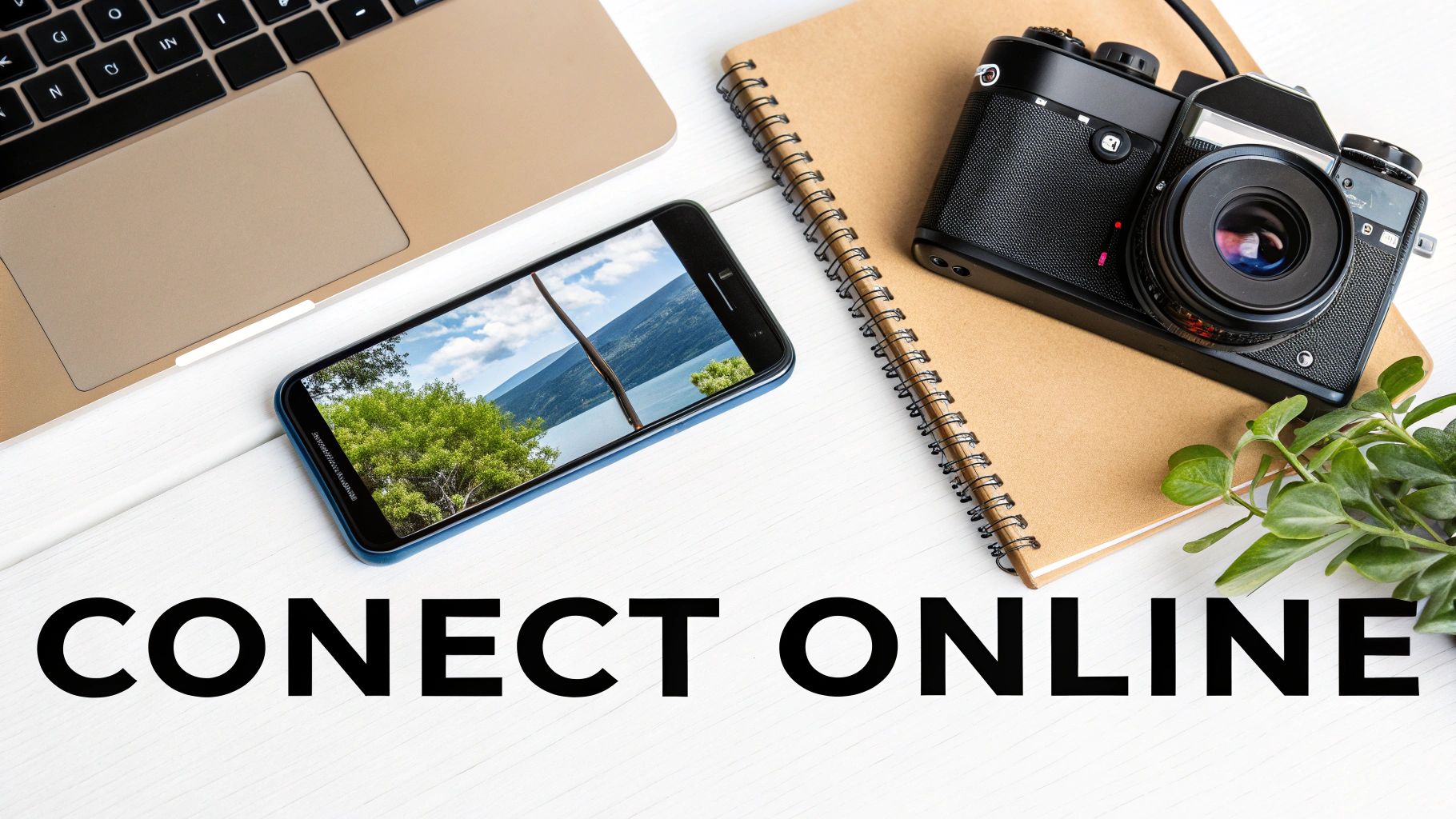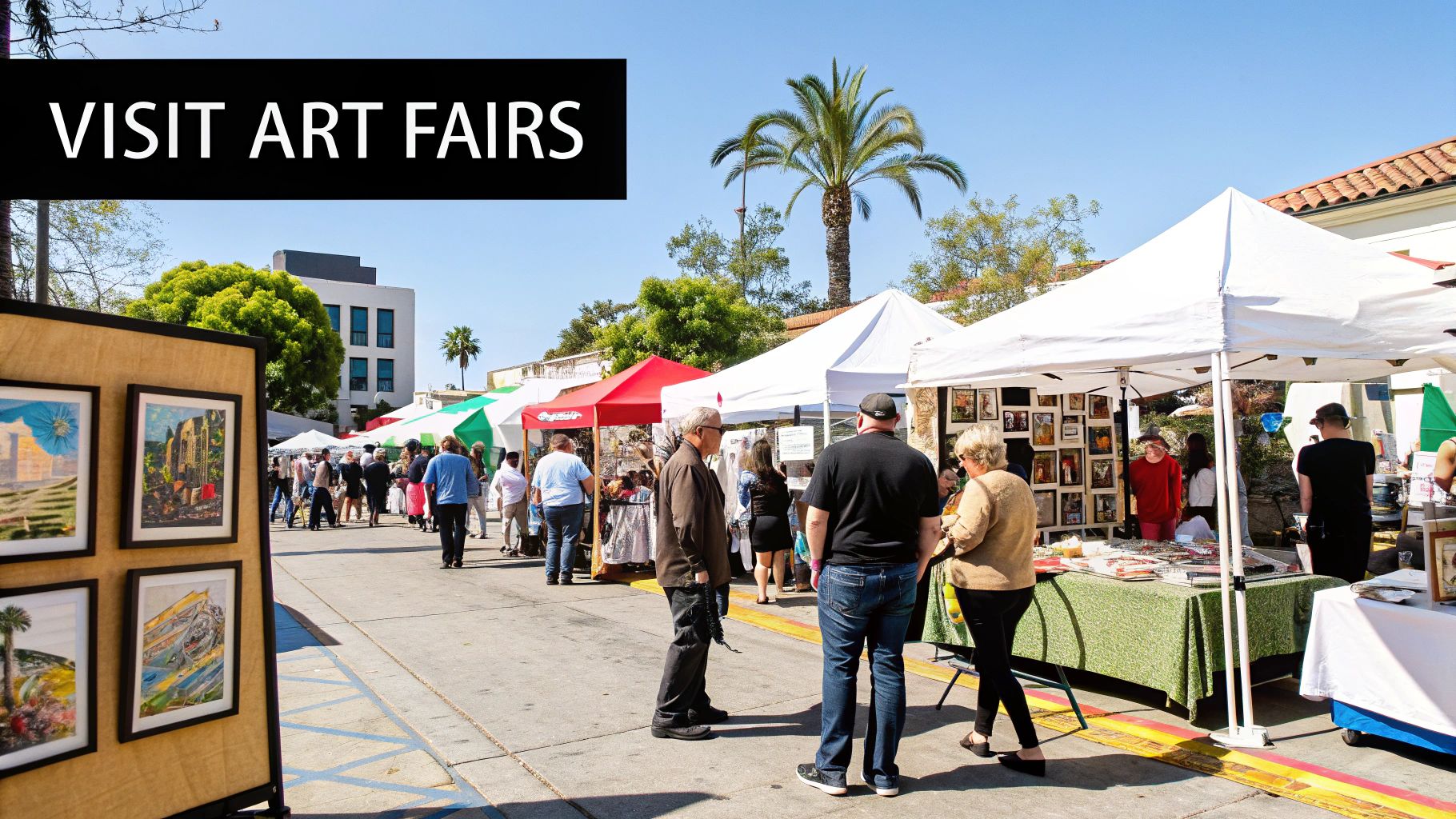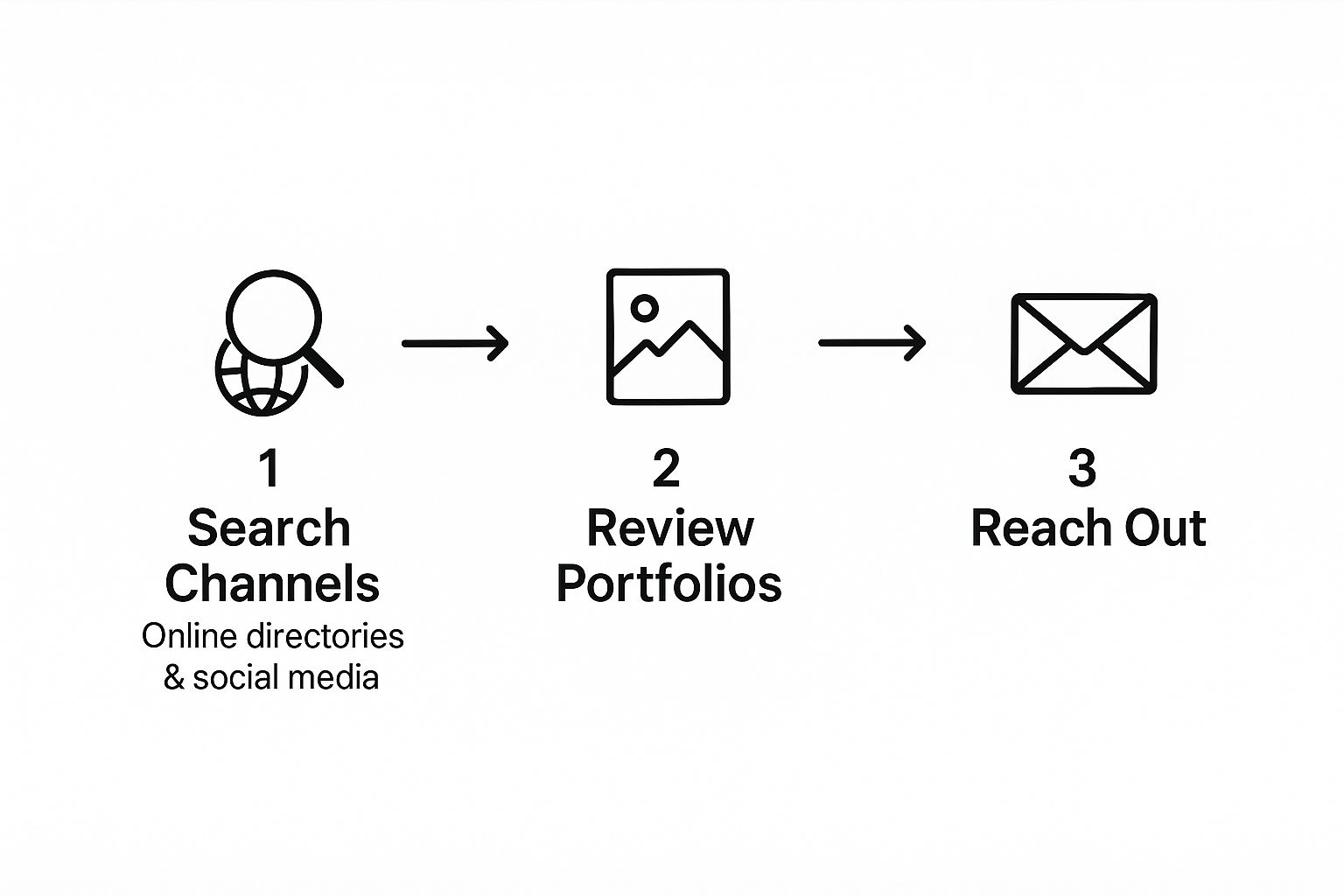So, you want to find some amazing local artists. Where do you even begin?
It really boils down to a few core strategies: digging through online search platforms, getting savvy with location-based hashtags on social media, and—my personal favorite—actually getting out into your community at galleries and art events. The magic happens when you mix the digital hunt with some real-world pavement-pounding. That's how you uncover the hidden talent right in your own backyard.

Your Guide to Discovering Local Artists
Whether you're an interior designer hunting for that perfect statement piece, a business owner looking to liven up the office, or just someone who wants to champion your city's creative pulse, the first step is knowing where to look. This guide isn't about generic advice; we're diving into the practical, nitty-gritty strategies that I and other art lovers use to connect with incredible local talent.
Discovering artists in your area is about so much more than just buying a painting. It’s an experience that pulls you deeper into your community's culture, revealing the stories and viewpoints that make your town unique. Plus, you’re often supporting a small business owner directly, which is a powerful way to fuel the local creative economy. This is a vital mindset for any creative entrepreneur aiming to build a career on their own terms.
Setting the Stage for Your Search
Before you dive headfirst into the search, it pays to have a rough idea of what you’re after. No need for a perfect vision, but asking yourself a few key questions can sharpen your focus and make the entire process way more successful.
Think about these starting points:
- What's the end goal? Are you looking for a single, show-stopping piece for your living room? A whole series of works for an office? Or are you just curious and exploring what's out there?
- What's your style? Do you gravitate towards abstract, landscapes, portraits, or sculpture? A quick search for these terms can help you dial in your preferences.
- What's your budget? Art is available at every price point. Knowing your range—whether you’re after an affordable print or a major original work—helps you filter your search from the get-go.
Having a clear purpose—even a loose one—transforms a vague hunt into a targeted mission. It helps you quickly identify which artists and venues are most relevant to you, saving time and making the process more enjoyable.
Think of this initial reflection as your compass. It'll guide you through all the different channels we’re about to explore, from specialized online platforms and social media rabbit holes to buzzing art walks and gallery openings. With this foundation, you're ready to start the journey.
Alright, let's get you connected with some amazing local artists. Your search probably starts online, which is great—that's where most of them are. The real trick isn't just mindlessly scrolling; it's about turning that screen time into a focused hunt for the creative talent right in your backyard.
The whole dynamic between artists and buyers has shifted. It's no longer just about who you know in the gallery scene. With the global art market expected to climb to $67 billion by 2025, a huge chunk of that growth is happening in more accessible price points. We're talking a 7% jump in art sales under $5,000. Why? Because artists can now connect directly with people like you online. No more gatekeepers.
Finding Artists on Social Media (The Right Way)
Instagram and Pinterest are visual goldmines, but you have to know how to dig. Forget generic tags like #art. That’s a firehose of content you’ll never get through.
You need to get specific and local. Think like this:
#[YourCity]Artists(e.g.,#SeattleArtists)#[YourNeighborhood]Art(e.g.,#WilliamsburgArt)#[YourState]Painters(e.g.,#TexasPainters)
When you find an artist you love, poke around in the hashtags they're using. It’s like a secret map that can lead you to a whole network of other local creators and art collectives.
Here’s a good example of what a solid artist profile on Instagram looks like.
See how they're crystal clear about their location and what they do? Their feed is a mix of finished pieces and behind-the-scenes studio shots, which gives you a real feel for their work and process.
Look Beyond the 'Gram
Instagram is king, but it's not the only game in town. I've found some incredible artists by browsing Pinterest boards curated by local interior designers and bloggers. Seriously, it's a fantastic source of inspiration.
And don't sleep on Facebook Groups. Search for groups dedicated to your town’s art scene or community events—you'll find artists who are really plugged into the local scene there. Even a simple Google search for "local artists near me" can turn up some gems, especially if an artist has set up a Google Business Profile.
It’s worth paying attention to how artists market themselves online. Their ability to get seen locally is a huge part of how you’ll find them. It's really no different from the core principles of any good local business marketing strategy.
You might even find an artist's studio listed right on Google Maps. Artists who are serious about connecting with their community often put real effort into optimizing Google Maps visibility. Knowing this gives you an inside track to finding studios you might have otherwise missed. Think of your online search as the groundwork for building a handpicked list of local talent you're excited to support.
Exploring Your Local Art Scene In Person

As great as online platforms are, nothing beats seeing art in person. It’s a completely different experience.
Moving your search from the screen to the street is where you really start to find the good stuff. This is how you go from a list of names to a real human connection. It’s where you can feel the texture of a painting, appreciate the scale of a sculpture, and just get what an artist is trying to do.
Tapping directly into your city’s creative pulse is honestly one of the most rewarding ways to discover local talent. Think of your town as a living, breathing gallery.
Visit Galleries and Open Studios
The obvious starting point? Local art galleries. They exist to champion regional artists. Don't be intimidated; gallery owners are usually dying to talk about the artists they represent and can give you incredible insights into their work.
But visiting a gallery isn't just about what's on the walls. It's a chance to dig deeper.
Strike up a conversation with the gallerist. Ask them who they’re excited about. Who are the up-and-comers? They have their finger right on the pulse of the local scene.
An even better move is to hit up an open studio event or a city-wide art walk. These are goldmines because you get to:
- Meet artists in their element. This gives you a peek into their process and personality that you can't get anywhere else.
- Hear the story behind the art. Learning the inspiration for a piece straight from the creator is powerful.
- See their full range of work. You'll often stumble upon works-in-progress or older pieces not on display in a formal gallery.
Look for Art in Unexpected Places
Your hunt for local artists shouldn’t stop at traditional venues. Tons of local businesses know that art creates a vibe. Keep an eye out for rotating exhibits in places like:
- Coffee Shops: Often the first place an emerging artist will show their work.
- Boutique Hotels: They’re increasingly curating collections from local creators to make their guest experience unique.
- Indie Bookstores and Restaurants: These community hubs love partnering with artists.
Seeing art in these spaces helps you imagine how a piece might actually look in your own home or office. It strips away the formal "white cube" gallery feel and makes the art more accessible.
These alternative spots are usually less crowded, too. You get more time to really take in the work and jot down the contact info for an artist who catches your eye.
Remember, the art market is a massive ecosystem. In 2024, the United States made up 43% of the global art market—that's a value of around $27.2 billion. This huge infrastructure means local artists have tons of channels, from high-end galleries to neighborhood cafes, to get their work seen.
As you start building your list of potential artists, it helps to know what comes next. You can check out our guide on how to hire designers and other creatives to get a head start on the process.
Go Beyond the Gallery: Connecting With Regional Art Hubs

Sometimes, the most incredible talent isn't hanging in a big-name gallery. It’s tucked away, thriving in the creative ecosystems of regional art hubs. If you expand your search just a little beyond your immediate neighborhood, you can tap into a much deeper, more authentic creative scene.
Think of university art departments, artist-run collectives, and local art centers as incubators for fresh ideas and raw talent. These are the places that often give a platform to artists who are really pushing boundaries. It’s your chance to discover them before they hit the mainstream market.
This couldn't be more true right now. The art world is seeing a massive shift, with a new focus on regional markets. All over the globe, local art scenes are getting stronger, building their own collector communities. Just look at the Middle Eastern art market—it’s seen a 298% explosion in auction sales since 2020, mostly driven by younger buyers.
This is a global trend, but you can apply the same thinking to your own backyard. It’s all about finding fertile ground where amazing talent has been previously overlooked. For a deeper dive on this, check out the 2025 art market forecast.
Tap Into University Art Programs
Here’s one of the best-kept secrets for finding emerging artists: go to a university’s Master of Fine Arts (MFA) thesis exhibition. Seriously. These shows are the culmination of years of intense, dedicated work, where graduate students are putting their most ambitious projects on display.
They're free, open to the public, and give you a direct line to the next generation of professional artists. You’ll see everything from experimental video installations to classic oil paintings. It’s a fantastic way to spot an artist’s potential right at a critical moment in their career.
Pro Tip: Don't just show up for the big thesis exhibition. Lots of universities host open studio days throughout the year. Follow the art department on social media or get on their newsletter list so these events land on your calendar.
Get Involved with Artist-Run Collectives
Artist-run collectives and co-ops are another goldmine. These are groups managed by artists, for artists. They share studio spaces, pool resources, and promote each other's work. By their very nature, they are grassroots operations and deeply plugged into the local creative community.
Getting involved with these collectives gives you a truly authentic look at what's happening on the ground.
Here’s how to connect:
- Follow them online. Most have active Instagram accounts where they announce shows, member news, and calls for art.
- Show up to their events. Go to their openings and artist talks. This is where the real community building and conversations happen.
- Join their mailing list. It’s still the most reliable way to stay in the loop about what they’re up to.
This kind of direct involvement is how you build real relationships in the art world. If you want more ideas on fostering these connections, our guide on community engagement best practices has you covered.
By supporting these hubs, you’re not just finding incredible local artists—you’re helping sustain the very infrastructure that allows them to create and thrive.
How to Thoughtfully Evaluate and Approach an Artist
So, you’ve found a few local artists whose work really speaks to you. Awesome. Now comes the part where we move from just discovering to actually connecting. It's about looking past that initial "wow" factor and digging a little deeper into their craft.
I know it’s tempting to fire off a quick DM the second you see something you love. We've all been there. But taking a moment to do a little homework shows you’re a serious collector, not just another notification. It builds respect right from the start.
Diving Into an Artist's Portfolio
The first stop is always their online portfolio. Think of it as their professional showcase—it tells you way more than just what their art looks like. As you browse, you're really looking for signals that point to a dedicated and evolving artist.
Here's what I always keep an eye out for:
- A Cohesive Vibe: Is there a clear, consistent style or theme? Artists absolutely evolve, but a strong portfolio should feel like a focused body of work, not just a random collection of experiments.
- A Unique Voice: Does the work feel fresh? You’re looking for an artist who has something to say, a perspective that’s truly their own and stands out from the noise.
- The Craftsmanship: Get close—or as close as the screen allows. Look at the brushstrokes, the clean lines of a print, or the form of a sculpture. You can often see the level of care and technical skill poured into each piece.
Your goal here isn't to be a harsh critic. It's to get a feel for the artist’s journey and commitment. A well-curated portfolio isn't just a gallery; it's a visual resume that tells a story about their dedication and artistic direction.
If you want to see what a standout portfolio looks like in the wild, checking out some great creative portfolio website examples can give you a solid benchmark.
This whole process—from searching to connecting—can feel a bit overwhelming, but it's simpler than you think.

Following a simple flow like this helps you make an informed and respectful connection every time.
To make this process even more concrete, I've put together a quick checklist. It's what I use to systematically review an artist's work before I even think about sending that first message.
Artist Evaluation Checklist
| Evaluation Criteria | What to Look For | Where to Find Info |
|---|---|---|
| Artistic Style | A consistent and recognizable aesthetic across their body of work. | Artist's portfolio, Instagram grid, gallery exhibitions. |
| Technical Skill | Execution quality—brushwork, composition, line work, material use. | High-resolution images on their website, in-person viewings. |
| Originality | A unique perspective or concept that feels fresh and distinct. | Artist statement, project descriptions, interviews. |
| Professionalism | A well-maintained website, clear contact info, active social media. | Their official website, LinkedIn, social media profiles. |
| Artist's Story | Their background, inspirations, and the "why" behind their work. | "About" page, blog posts, artist statements, interviews. |
| Community Engagement | Participation in local art shows, collaborations, workshops. | Social media announcements, local gallery websites, event listings. |
This checklist isn’t about ticking every single box. It’s a guide to help you build a complete picture of the artist and their practice, ensuring you’re reaching out for all the right reasons.
Making Contact Like a Pro
Alright, you've done your homework. Now it’s time to reach out.
Whether you slide into their DMs, send an email, or chat with them at an event, how you do it matters more than where. The key is to be personal, specific, and respectful of their time.
Please, avoid the generic "I love your work!" message. Instead, get specific. Try something like, "Hi [Artist Name], I was blown away by your painting 'Sunset Over the Lake' at the [Gallery/Event Name] opening. The way you captured the light was just incredible."
See the difference? It shows you’ve actually paid attention.
If you’re writing, keep it brief and to the point. State your purpose clearly, whether you want to buy a piece you saw, ask about a commission, or just get on their price list. Starting the conversation professionally and directly is the best way to get a positive response and build a real connection.
Got questions about finding and buying art from local creators? You're not alone.
When you're first dipping your toes into the local art scene, a few things can feel a little confusing. It's totally normal. Getting the inside scoop on the unwritten rules, from pricing to studio etiquette, will help you connect with artists confidently and respectfully.
Let's break down some of the most common questions that come up.
How Much Should I Expect to Pay for Local Art?
Ah, the million-dollar question. The honest-to-goodness answer is: it really, really varies. There’s no single price tag for "local art." A few things have a huge impact on the final number.
- The artist's journey: Someone fresh out of art school is going to have a very different price point than an established artist who’s been showing in galleries for a decade or more.
- The medium matters: Think about the materials and time involved. A massive oil painting that took months to complete will naturally cost more than a beautiful, smaller watercolor or a limited-edition print.
- Size and scale: This one’s pretty straightforward. Larger works generally come with higher prices.
The best way to get a feel for an artist’s pricing is to poke around their website for a "shop" or "available work" section. You can also check out their pieces at a local gallery, which will almost always have prices listed. You might find small prints for under $100, while original paintings can start at a few hundred and go up into the thousands.
It's easy to just see the price tag, but remember what you're really paying for: the artist's years of practice, their unique vision, and the slice of their life they poured into that single piece. It's an investment in skill and creativity.
Can I Haggle on the Price?
This is a tricky one, and you have to read the room. Whether it's okay to negotiate really depends on where you're buying and how you go about it.
If you're buying directly from an artist, maybe at their studio, there might be a little wiggle room. We're talking a small, respectful discount, maybe in the 10% range. But you have to handle this conversation with care. Please, never lead with a lowball offer. It's a quick way to offend an artist and kill any potential for a good relationship.
Buying from a gallery? That's a different story. Galleries have their own costs to cover and a commission they owe the artist, so the price you see is almost always firm. It's best to assume the listed price is the final price in that setting.
What's the Right Way to Ask for a Studio Visit?
Getting to see an artist's studio is an incredible experience—it’s like a backstage pass into their creative world. But it's a privilege, not a given. Their studio is their private workspace, so your approach needs to be thoughtful and professional.
The best way in is a polite email or a direct message. Don't just show up unannounced. Here’s a simple, human way to do it:
- Start with a quick, friendly introduction.
- Be specific. Mention a piece or two of their work you genuinely love. This shows you've actually looked at their art and aren't just sending a generic message.
- Be clear about why you're reaching out. Let them know you're interested in their work and would be honored to see more in person.
- Finally, ask if they are open to scheduling visits by appointment. This gives them an easy "out" if they're swamped or just not doing visits right now.
This kind of respectful approach shows you're a serious potential patron who values their time and space. That alone makes them much more likely to say yes.
Ready to find your next creative partner? Creativize is a platform built to connect you with incredible local talent, from standout graphic designers to visionary animators. With detailed portfolios and verified reviews, you can easily find the perfect pro for any project. Start building your dream team today at https://creativize.net.

